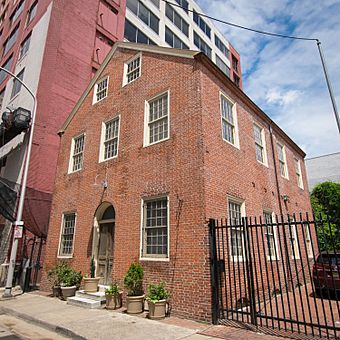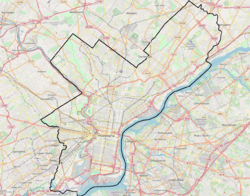Adelphi School facts for kids
Quick facts for kids |
|
|
Adelphi School
|
|
 |
|
| Location | 1223–1225 Spring St., Philadelphia, Pennsylvania |
|---|---|
| Area | 0.5 acres (0.20 ha) |
| Built | 1831 |
| Architectural style | Federal |
| NRHP reference No. | 78002441 |
| Added to NRHP | September 18, 1978 |
The Adelphi School was a special school in Philadelphia. It was started by a group called the Quakers. This school helped poor children get an education for free. It operated from 1808 to 1906. The school was located in what is now the Chinatown area of Philadelphia.
At first, the Adelphi School taught white boys. Later, it changed to teach black children. This happened after public schools started in Pennsylvania. The school ran on money given by kind people. Students never had to pay to attend. The building used for the school from 1832 is very old. It is believed to be the last free school building left in Philadelphia. In 1978, it was added to the National Register of Historic Places. This means it's an important historical site.
Contents
How the Adelphi School Began
In 1807, some Quakers in Philadelphia wanted to help poor children. They formed a group to teach these children. This group was called the Philadelphia Association of Friends for the Instruction of Poor Children. Only Quakers could be members of this group.
The Quakers wanted to build schools using a new teaching method. This method was called the Monitorial System. It allowed one teacher to teach many students at once. This effort was part of a bigger movement. Quakers often started charity schools for the poor. They did this before public schools were common in the United States.
Early Years of the School
The Association raised money from donations. They opened their first school in 1808. It was for white boys. Soon, about 90 students were attending. To fit more students, they raised $7000 for a new building. This new building was on Pegg Street.
In 1809, the school moved to this new place. It was then named "the Adelphi School." By 1812, girls also started attending. About one-third of the 330 students that year were girls. The school had its most students in 1814, with 582 pupils.
A New Focus for Education
In 1818, Philadelphia started its own public school system. These schools were first for white children. A reformer named Roberts Vaux helped set them up. He was inspired by the Adelphi School. This was one of the first public school systems in the U.S.
The Quaker Association felt that poor white children were now being helped. So, they closed the Adelphi School that year. The Pegg Street building was rented to the public school system. After this, the Association focused on educating black children. They opened a new school for them in 1822.
The School's New Home
In 1825, the Adelphi School rented space from another group. This group was the Pennsylvania Abolition Society. Their schoolhouse was on Cherry Street. In 1831, the Abolition Society needed their building back. So, the Adelphi School moved to a temporary spot.
A new school building was then built on Wager Street. Today, this street is called Spring Street. The new building was made of brick. It was two and a half stories tall. It cost $3100 to build and $1200 for the land. The school opened in this new building in 1832. It was built in the Federal style. This style is simple, like many Quaker buildings.
Later Years and Legacy
The Wager Street Adelphi School opened its first floor in 1832. The whole building was finished in 1834. At first, it only accepted black boys of school age. But in 1835, it started taking younger children, both boys and girls. By 1838, they stopped teaching older boys. Instead, they focused on admitting girls.
The Adelphi School continued at this location for many years. A famous writer, W. E. B. Du Bois, wrote about it. In 1847, the school had 166 students. By the late 1800s, the number of students was around 67. Even with public schools, the Adelphi School was still important. It helped students who could not attend public schools for different reasons.
The Quaker Association ran the school until 1906. From 1908 to 1945, the Abolition Society owned the building. It was used for many activities. These included groups like the Boy Scouts. It also had sewing clubs and other educational programs. The goal was to improve the lives of African Americans in Philadelphia.
In 1978, the building was added to the National Register of Historic Places. This was because of its history. It was important for its architecture, education, religion, and humanitarian efforts. By that time, the building was privately owned. It was used for businesses.




